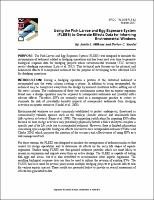Please use this identifier to cite or link to this item:
https://hdl.handle.net/11681/21640Full metadata record
| DC Field | Value | Language |
|---|---|---|
| dc.contributor.author | Wilkens, Justin L. | en_US |
| dc.contributor.author | Suedel, Burton C. | en_US |
| dc.creator | Environmental Laboratory (U.S.) | en_US |
| dc.creator | Dredging Operations and Environmental Research Program (U.S.) | en_US |
| dc.date.accessioned | 2017-03-29T19:07:13Z | en_US |
| dc.date.available | 2017-03-29T19:07:13Z | en_US |
| dc.date.issued | 2017-03 | en_US |
| dc.identifier.govdoc | ERDC TN-DOER-E42 | en_US |
| dc.identifier.uri | http://hdl.handle.net/11681/21640 | en_US |
| dc.identifier.uri | http://dx.doi.org/10.21079/11681/21640 | en_US |
| dc.description | Technical Note | en_US |
| dc.description.abstract | Purpose: The Fish Larvae and Egg Exposure System (FLEES) was designed to simulate the resuspension of sediment related to dredging operations and has been used over time to generate biological response data for dredging projects where environmental windows (EW) severely restrict dredging operations (Lutz et al. 2012). This technical note focuses on the physical and behavioral effects of resuspended sediment for the purpose of developing better informed EWs for dredging operations. | en_US |
| dc.description.sponsorship | Dredging Operations and Environmental Research Program (U.S.) | en_US |
| dc.format.extent | 9 pages/1 MB | en_US |
| dc.format.medium | en_US | |
| dc.language.iso | en_US | en_US |
| dc.publisher | Engineer Research and Development Center (U.S.) | en_US |
| dc.relation.ispartofseries | Technical Note (Dredging Operations and Environmental Research Program (U.S.)) ; no.ERDC TN-DOER-E42 | en_US |
| dc.rights | Approved for public release; distribution is unlimited | en_US |
| dc.source | This Digital Resources was created in Microsoft Word and Adobe Acrobat | en_US |
| dc.subject | Dredging--Environmental aspects | en_US |
| dc.subject | Sedimentation and deposition | en_US |
| dc.subject | Fishes--Eggs | en_US |
| dc.subject | Dredging Operations and Environmental Research Program (U.S.) | en_US |
| dc.title | Using the Fish Larvae and Egg Exposure System (FLEES) to generate effects data for informing environmental windows | en_US |
| dc.type | Report | en_US |
| Appears in Collections: | Technical Note | |
Files in This Item:
| File | Description | Size | Format | |
|---|---|---|---|---|
| ERDC TN-DOER-E42.pdf | ERDC TN-DOER-E42 | 1 MB | Adobe PDF |  View/Open |